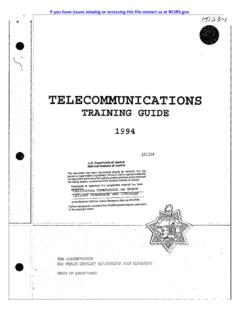Transcription of Electronic Crime Scene Investigation: A Guide for First ...
1 Department of Justice Office of Justice Programs National Institute of Justice APR. 08. Special REPORT. Electronic Crime Scene Investigation: A Guide for First Responders, Second Edition Department of Justice Office of Justice Programs 810 Seventh Street Washington, DC 20531. Michael B. Mukasey Attorney General Jeffrey L. Sedgwick Acting Assistant Attorney General David W. Hagy Director, National Institute of Justice This and other publications and products of the National Institute of Justice can be found at: National Institute of Justice Office of Justice Programs Innovation Partnerships Safer Neighborhoods APR.
2 08. Electronic Crime Scene Investigation: A Guide for First Responders, Second Edition Cover photographs copyright 2001 PhotoDisc, Inc. NCJ 219941. David W. Hagy Director, National Institute of Justice This document is not intended to create, does not create, and may not be relied upon to create any rights, substantive or procedural, enforceable as law by any party in any matter civil or criminal. Photos used in this document are taken from public Web sites; they are in no way an endorsement of the product illustrated.
3 The opinions or points of view expressed in this document represent a consensus of the authors and do not necessarily represent the offi . cial position or policies of the Department of Justice. The prod . ucts and manufacturers discussed in this document are presented for informational purposes and do not constitute product approval or endorsement by the Department of Justice. The National Institute of Justice is a component of the Office of Justice Programs, which also includes the Bureau of Justice Assistance; the Bureau of Justice Statistics; the Community Capacity Development Office; the Office for Victims of Crime ; the Office of Juvenile Justice and Delinquency Prevention; and the Office of Sex Offender Sentencing, Monitoring, Apprehending, Registering, and Tracking (SMART).
4 Contents Introduction.. vii Using This Guide .. viii Intended Audience for This Guide .. viii What Is Digital Evidence? .. ix Handling Digital Evidence at the Scene .. ix Is Your Agency Prepared to Handle Digital Evidence? .. x Chapter 1. Electronic Devices: Types, Description, and Potential Evidence .. 1. Computer Systems .. 1. Storage Devices .. 3. Handheld Devices .. 7. Peripheral Devices .. 8. Other Potential Sources of Digital Evidence .. 9. Computer Networks .. 11. Chapter 2. Investigative Tools and Equipment.
5 13. Tools and Materials for Collecting Digital Evidence .. 13. Chapter 3. Securing and Evaluating the Scene .. 15. Preliminary Interviews .. 17. Chapter 4. Documenting the Scene .. 19. iii Chapter 5. Evidence Collection .. 21. Computers, Components, and Devices .. 21. Other Forms of Evidence .. 27. Other Electronic and Peripheral Devices of Potential Evidential Value .. 27. Computers in a Business Environment .. 30. Chapter 6. Packaging, Transportation, and Storage of Digital Evidence .. 31. Packaging Procedures.
6 31. Transportation Procedures .. 32. Storage Procedures .. 33. Chapter 7. Electronic Crime and Digital Evidence Considerations by Crime Category.. 35. Child Abuse or Exploitation .. 36. Computer Intrusion .. 37. Counterfeiting.. 38. Death Investigation .. 38. Domestic Violence, Threats, and Extortion .. 39. E-mail Threats, Harassment, and Stalking .. 40. Gambling .. 41. Identity Theft.. 41. Narcotics .. 42. Online or Economic Fraud .. 43. iv Prostitution .. 44. Software Piracy .. 45. Telecommunication Fraud.
7 45. Terrorism (Homeland Security) .. 46. Glossary .. 49. v Introduction This Guide is intended to assist State and local law enforce . ment and other First responders who may be responsible for preserving an Electronic Crime Scene and for recognizing, col . lecting, and safeguarding digital evidence. It is not all inclusive but addresses situations encountered with Electronic Crime scenes and digital evidence. All Crime scenes are unique and the judgment of the First responder, agency protocols, and prevailing technology should all be considered when imple.
8 Menting the information in this Guide . First responders to Electronic Crime scenes should adjust their practices as cir . cumstances including level of experience, conditions, and available equipment warrant. The circumstances of individual Crime scenes and Federal, State, and local laws may dictate actions or a particular order of actions other than those described in this Guide . First responders should be familiar with all the information in this Guide and perform their duties and responsibilities as circumstances dictate.
9 When dealing with digital evidence, general forensic and procedural principles should be applied: The process of collecting, securing, and transporting digital evidence should not change the evidence. Digital evidence should be examined only by those trained specifically for that purpose. Everything done during the seizure, transportation, and storage of digital evidence should be fully documented, preserved, and available for review. First responders must use caution when they seize Electronic devices.
10 Improperly accessing data stored on Electronic devices may violate Federal laws, including the Electronic Communications Privacy Act of 1986 and the Privacy Protection Act of 1980. First responders may need to obtain additional legal authority before they proceed. They should consult the prosecuting attorney for the appropriate jurisdiction vii to ensure that they have proper legal authority to seize the digital evidence at the Scene . In addition to the legal ramifications of improperly accessing data that is stored on a computer, First responders must understand that computer data and other digital evidence are fragile.
















